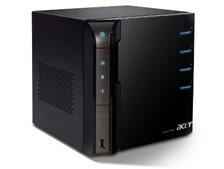
A couple of years ago I bought a Acer Aspire easyStore H340 to use as a home NAS device. While the H340 came with Windows Server, I decided to replace it with Debian Linux running on an external USB stick. Besides using it for basic file storage, I use Nginx to stream MP4s to Roku devices throughout my home using Roksbox; I use forked-daapd to stream FLACs to iTunes (albeit with limited success – foobar2000 pointing to the CIFS file share works better); and I use CrashPlan to back up my important data (e.g. pictures) to the Internet.
Two days ago, S.M.A.R.T. indicated that hard drive which originally came with the machine was failing, so I replaced it with a spare I had on-hand. I replaced the hard drive, rebuilt the RAID5 array, and everything seemed fine. However, after upgrading Debian to the latest kernel, the machine failed to boot.
I attached my VGA debugging cable and determined that the machine appeared to be having issues with the boot order. Using the H340 service manual as a reference, I attached a spare jumper to JP3 and changed the boot order in the BIOS. I heard that if you removed this jumper the machine would restore to its default boot order, so I left the jumper in and put everything back.
Mission accomplished.